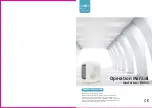
B. Settlement of outdoor unit
1) Anchor the outdoor unit with a bolt and nut
tightly and horizontally on a concrete or rigid mount.
2) When installing on the wall, roof or rooftop, anchor
the mounting base securely with a nail or wire assum-
ing the influence of wind and earthquake.
3) In the case when the vibration of the unit is conveyed
to the hose, secure the unit with an anti-vibration rub -
ber.
3
.9 Test running
1) Check that all tubing and wiring have been properly
connected.
2) Check that the gas and liquid side service valves are
fully open.
A. Prepare remote control
1) Remove the battery cover by
pulling it according to the arrow
direction.
2) Insert new batteries making sure
that the (+) and (–) of battery
are installed correctly.
3) Reattach the cover by pushing it
back into position.
NOTE:
• Use 1.5volt batteries. Do not use rechargeable
batteries.
• Remove the batteries from the remote control if the
system is not going to be used for a long time.
C. Evaluation of the performance
Operate unit for 15~20 minutes, then check the system
refrigerant charge:
1. Measure the pressure of the gas side service valve.
2. Measure the temperature of the intake and discharge
of air.
NOTE:
If the actual pressure are higher than shown, the system
is most likely over-charged, and charge should be
removed. If the actual pressure are lower than shown,
the system is most likely undercharged, and charge
should be added.
The air conditioner is now ready for use.
Bolt
Tubing connection
Outside ambient TEMP. The pressure of the gas side service valve
35°C(95°F)
4~
6
kg/cm
2.
G(56.8~
85.2
P.S.I.G.)
This is performed when the unit is to be relocated or
the refrigerant circuit is serviced.
Pump Down means collecting all refrigerant in the out-
door unit without loss in refrigerant gas.
CAUTION:
Be sure to perform Pump Down procedure with the unit
cooling mode.
Pump Down Procedure
1. Connect a low-pressure gauge manifold hose to the
charge port on the gas side service valve.
2. Open the gas side service valve halfway and purge the air
from the manifold hose using the refrigerant gas.
3. Close the liquid side service valve(all the way in).
4. Turn on the unit's operating switch and start the cooling
operation.
5. When the low-pressure gauge reading becomes 1 to
0.5kg/cm
2.
G(14.2 to 7.1 P.S.I.G.), fully close the gas side
valve stem and then quickly turn off the unit. At that time,
Pump Down has been completed and all refrigerant gas
will have been collected in the outdoor unit.
PUMP DOWN
3. Ensure the difference between the intake temperature
and the discharge is more than 8 °C (Cooling) or
reversely (Heating).
4. For reference; the gas side pressure of optimum condi -
tion is as below.(Cooling)
Discharge air
Intake temperature
Discharge temperature
Installation Instructions • T-series Split System Air Conditioner
Page 14

































